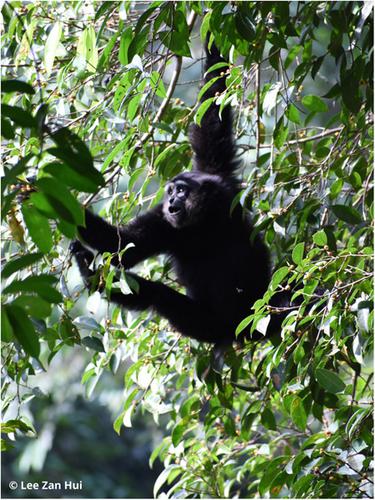当前位置:
X-MOL 学术
›
Am. J. Primatol.
›
论文详情
Our official English website, www.x-mol.net, welcomes your feedback! (Note: you will need to create a separate account there.)
Population densities of Hylobates agilis in forests with different disturbance histories in Ulu Muda Forest Reserve, Malaysia
American Journal of Primatology ( IF 2.4 ) Pub Date : 2022-05-06 , DOI: 10.1002/ajp.23388 Yi Heng Pang 1, 2 , Susan Lappan 1, 2, 3 , Thad Q Bartlett 2, 4 , Shahrul Anuar Mohd Sah 1 , Nik Fadzly N Rosely 1 , Nadine Ruppert 1, 2
American Journal of Primatology ( IF 2.4 ) Pub Date : 2022-05-06 , DOI: 10.1002/ajp.23388 Yi Heng Pang 1, 2 , Susan Lappan 1, 2, 3 , Thad Q Bartlett 2, 4 , Shahrul Anuar Mohd Sah 1 , Nik Fadzly N Rosely 1 , Nadine Ruppert 1, 2
Affiliation

|
Small ape habitat throughout Malaysia is rapidly being lost, degraded, and fragmented, and the effects of these changes on the abundance on this taxon are currently unknown. This study assessed the group density of Hylobates agilis in virgin forest, previously logged forest (1960s–1990s), and recently logged forest (2015–2017) of the Ulu Muda Forest Reserve (UMFR), Kedah, Malaysia. We conducted fixed-point active acoustic triangulation at nine survey areas to estimate group density. We used vegetation “speed plots” and satellite imagery to quantify habitat characteristics and used model selection to identify ecological predictors of group density variation. The estimated group density of H. agilis in UMFR was 4.03 ± 0.14 groups km−2, with an estimated total of 2927 ± 102 groups in areas below 450 m a.s.l. in UMFR. Group density did not differ significantly among habitat types. The best ecological predictors for group density were canopy cover and proportion of deforested area. Areas with recent deforestation were associated with relatively high group densities, suggesting compression of the populations persisting in these habitat types. The consistently high group densities detected in all forest types emphasizes the importance of degraded forest as habitat for H. agilis. Because of the threats to small apes in Malaysia, and the uncertain status of most populations, we recommend a nationwide population census and regular monitoring to inform conservation planning and implementation. Most urgently, we call for immediate and permanent protection of UMFR and other forests in the Greater Ulu Muda landscape to protect the globally significant populations of H. agilis, as well as other charismatic and threatened megafauna, birds, and flora in the area.
中文翻译:

马来西亚乌鲁慕达森林保护区不同干扰历史森林中敏捷长臂猿的种群密度
整个马来西亚的小猿栖息地正在迅速消失、退化和支离破碎,而这些变化对该类群丰度的影响目前尚不清楚。本研究评估了马来西亚吉打州乌鲁慕达森林保护区 ( UMFR ) 的原始森林、先前采伐的森林 (1960-1990 年代) 和最近采伐的森林 (2015-2017) 中敏捷长臂猿的群体密度。我们在九个调查区域进行了定点主动声学三角测量,以估计群体密度。我们使用植被“速度图”和卫星图像来量化栖息地特征,并使用模型选择来识别群体密度变化的生态预测因子。UMFR 中敏捷嗜血杆菌的估计组密度为 4.03 ± 0.14组km -2,在 UMFR 中 450 m asl 以下的地区估计共有 2927 ± 102 个组。栖息地类型之间的群体密度没有显着差异。群体密度的最佳生态预测因子是冠层覆盖和森林砍伐面积的比例。最近森林砍伐的地区与相对较高的群体密度有关,这表明在这些栖息地类型中持续存在的人口受到压缩。在所有森林类型中检测到的始终如一的高群体密度强调了退化森林作为敏捷汉密尔顿栖息地的重要性. 由于马来西亚小类人猿面临的威胁,以及大多数人口的不确定状况,我们建议进行全国人口普查和定期监测,为保护规划和实施提供信息。最紧迫的是,我们呼吁立即和永久保护大乌鲁穆达景观中的 UMFR 和其他森林,以保护全球重要的敏捷汉族种群,以及该地区其他具有魅力和受威胁的巨型动物、鸟类和植物群。
更新日期:2022-05-06
中文翻译:

马来西亚乌鲁慕达森林保护区不同干扰历史森林中敏捷长臂猿的种群密度
整个马来西亚的小猿栖息地正在迅速消失、退化和支离破碎,而这些变化对该类群丰度的影响目前尚不清楚。本研究评估了马来西亚吉打州乌鲁慕达森林保护区 ( UMFR ) 的原始森林、先前采伐的森林 (1960-1990 年代) 和最近采伐的森林 (2015-2017) 中敏捷长臂猿的群体密度。我们在九个调查区域进行了定点主动声学三角测量,以估计群体密度。我们使用植被“速度图”和卫星图像来量化栖息地特征,并使用模型选择来识别群体密度变化的生态预测因子。UMFR 中敏捷嗜血杆菌的估计组密度为 4.03 ± 0.14组km -2,在 UMFR 中 450 m asl 以下的地区估计共有 2927 ± 102 个组。栖息地类型之间的群体密度没有显着差异。群体密度的最佳生态预测因子是冠层覆盖和森林砍伐面积的比例。最近森林砍伐的地区与相对较高的群体密度有关,这表明在这些栖息地类型中持续存在的人口受到压缩。在所有森林类型中检测到的始终如一的高群体密度强调了退化森林作为敏捷汉密尔顿栖息地的重要性. 由于马来西亚小类人猿面临的威胁,以及大多数人口的不确定状况,我们建议进行全国人口普查和定期监测,为保护规划和实施提供信息。最紧迫的是,我们呼吁立即和永久保护大乌鲁穆达景观中的 UMFR 和其他森林,以保护全球重要的敏捷汉族种群,以及该地区其他具有魅力和受威胁的巨型动物、鸟类和植物群。

























 京公网安备 11010802027423号
京公网安备 11010802027423号